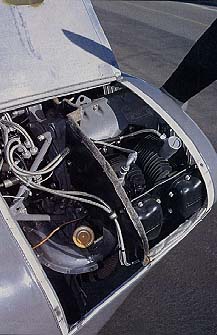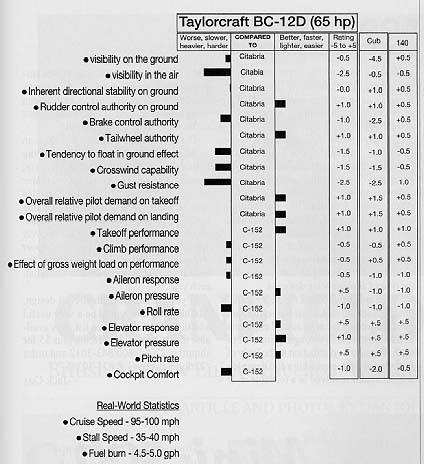T-Craft Flight Characteristics
We prevailed on Gary Towner, an FAA airline maintenance inspector
in Phoenix, to let us use his freshly restored BC-12D as the test
vehicle to remind us how a T-craft flies. Towner says when he
bought his Taylorcraft, it was a flying airplane but in need of
complete restoration. In the course of taking it apart he found
the spars were riddled with cracks. As he put it, "...they
were really scary looking." He feels all owners of aircraft
that old should take note of his experience in that area.
His airplane was, as near as he can determine, originally a
BC-12D-1, which he says was the bottom line, low-buck airplane
that didn't even have a left door. The second door was added sometime
in the 1970's by a previous owner.
As with most two-place, side by side airplanes of the era,
getting in is as much a project as flying it. In the T-craft it
is made more difficult by a diagonal brace running across the
end of the seat.
Once loaded up, Gary and I were, shall we say, "cozy."
Our shoulders were definitely touching part of the time. We didn't
measure the cockpit, but it is probably several inches narrower
than a C-150/152. Visibility over the nose, however, was good
without even stretching. This was important because the headliner
was nearly touching my head and I would have touched it if I had
to stretch. Part of the Taylorcraft's speed comes from having
low frontal area and this means a low cabin. It is low enough,
in fact, that turning your head sideways puts your eyes right
in the middle of the wing root. To see to the side requires ducking
down quite a bit. This is more of an aggravation than a danger,
but the lack of visibility is something to be remembered at all
times.
 The big control wheels
are fun and the brake pedals are funny. They are two tiny, thumb
sized pedals located well back and right between the rudder pedals.
They are nearly touching one another. Fortunately, they are used
very little in normal flight.
The big control wheels
are fun and the brake pedals are funny. They are two tiny, thumb
sized pedals located well back and right between the rudder pedals.
They are nearly touching one another. Fortunately, they are used
very little in normal flight.
Taxiing is straight forward with the only complication being
having to look down to dial frequencies into the handheld radio
mounted between us on the front seat edge. That location keeps
the cockpit looking absolutely original.
I hadn't been in a Taylorcraft in years and my primary memory
was one of the airplane flying as if it was very light. Gary's
airplane re-enforced that memory. As soon as the power was up,
the airplane wanted to fly and I barely had the tail up before
it floated off. The tail is so far behind us, it has lots of authority
so very little rudder movement was needed to keep it straight.
We had barely a breath of wind, maybe two or three knots, across
the runway. Most airplanes wouldn't have even noticed that wind,
but the second we left the ground, the Taylorcraft instantly reacted
to the wind by drifting. I found myself crabbing into a wind the
windsock barely recognized as being there.
The airplane has a definite thistle down feeling to it and
wind is a challenge to it. The best pilot on any airport is the
Taylorcraft pilot who easily and routinely conquers a gusty crosswind.
With firm hands, the airplane will handle more crosswind than
is prudent, but most folks study the windsock carefully before
pulling the airplane out. With such a light wing loading and those
long wings, it's second cousin to a parachute.
It was fairly cool out, about 70°, and the airplane responded
by giving us a fairly solid rate of climb in the 400-500 fpm range
at about 65-70 mph. Gary says he gets about half that during the
summer and prefers to fly the airplane solo in those situations.
The air was liquid smooth so we didn't have much turbulence
to show the Taylorcraft's cork-like ability to ride over even
the softest bump. We also didn't have any thermals to help us
to altitude. More than any of its peers, the Taylorcraft is eager
to lock on to even the weakest thermal and convert it into altitude.
As we leveled off, the airspeed stabilized at 90-95 mph and
Gary says he can flight plan 95-100 mph and be fairly close. He's
generally burning around 4.5 gallons per hour and, considering
his airplane has both wing tank options as well as the fuselage
tank, the airplane will stay in the air far longer than he can.
The ability to go long distances in a reasonable time on pennies
has always the Taylorcraft's long suit.
Because Gary had gone completely through the control system,
including installing ball bearing pulleys, his controls were surprisingly
smooth. There was none of the common feeling that a cable was
sawing a pulley in half. Also, when racking the ailerons around,
the airplane was quite willing to respond. We're not talking Pitts
Special roll rates here, but even with those long wings, it rolled
faster than most of its peers.
Adverse yaw is significant, but not as much as a Champ and
about the same as a Cub. The amount of rudder required to coordinate
is minimal, but definitely there. In checking pitch stability,
it damped out completely in less than three cycles when pulled
ten mph off trim speed.
Doing stalls was, as is usually the case with this period of
airplane, almost a waste of time because they are so benign. In
a normal, slow approach to a stall, the wheel hit the stop somewhere
in the low 40 mph range and the airplane just mushed. If accelerated,
either in a turn or straight, it would break slightly and then
mush. During the process I was careful to keep the ball centered
because the rudder is very effective at those slow speeds. As
I remember, if asked, the airplane spins very nicely and willingly,
with a positive recovery.
There's no doubt you're in a fairly small cabin, when cruising.
Even though you can see over the nose quite well, your eyes are
closer to the thrust line than we're used to so the visual down
angle is pretty flat. Also, the necessity to duck to see sideways
is always there. The overall feeling is one of being in a long,
narrow cabin, when really it's the vertical height that gives
that illusion. Skylights would probably open up the cabin feeling
considerably.
When we came back into the pattern, I reminded myself that
this airplane would really glide, so I spaced us out accordingly
on base. Even so, I was too high. Fortunately, the airplane is
a good slipping machine. Not as good as a Cub, but still good.
Gary said he uses 70 mph, so I did too, which seemed to work out
fine.
As I came out of the slip and into ground effect, the Taylorcraft's
reputation as a floater was again re-enforced. We may have been
a little fast, but, as we floated along while I felt for the ground,
I was very conscious of having to be very judicious with what
I did with the elevators. Just the slightest amount of too much
back pressure and the airplane would try to balloon. Since we
were slowing to a near-walk this was more of a game, than anything
else. The airplane clearly telegraphed when it was about to settle
or balloon and I just had to adjust accordingly.

After a few seconds of floating, it would give up and settle
on to the ground. On one, I held it off just a little too long
and felt it unhook and drop us the last several inches. That surprised
me, but shows it's not a good idea to hang it on top of ground
effect for too long.
All of the landings were three-pointers, some better than others,
and none were even remotely challenging during roll-out. The airplane
didn't want to do anything unusual and was at least as easy as
a Champ or Cub to control. The wind had pretty much died down,
so we had the best of all possible situations going for us.
The T-craft is actually quite a good bargain, even in this
period of rapidly inflating classic airplane prices. A quick perusal
of Trad-a-Plane showed that even the restored airplanes seldom
touched $20,000 with many restored ones with low-time engines
at $15,000 and below. Unrestored airplanes were in the $10,000-$12,000
range. When buying an unrestored airplane, however, inspect it
very carefully. At sometime in its life, it was doing duty as
shelter for all types of mice and varmints. When buying a newly
recovered airplane, make certain all the rust and rot problems
were attended to.
For the final word on Taylorcrafts, contact:
Taylorcraft Owner's Club
Bruce Bixler, President
12809 Greenbower, N.E.
Alliance, OH 44601
330/823-9748
For lots more pilot
reports like this one go to PILOT
REPORTS
 The big control wheels
are fun and the brake pedals are funny. They are two tiny, thumb
sized pedals located well back and right between the rudder pedals.
They are nearly touching one another. Fortunately, they are used
very little in normal flight.
The big control wheels
are fun and the brake pedals are funny. They are two tiny, thumb
sized pedals located well back and right between the rudder pedals.
They are nearly touching one another. Fortunately, they are used
very little in normal flight.